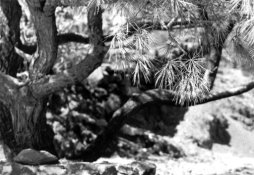Jim, time to start with the basics again. Film speed, exposure, aperture, shutter speed, tripod, cable release, development, print. One thing I did to get sharper images was to go to a heavy tripod way back when, but is sounds like this isn't an option for you at this point. Next best thing is shutter speed, no movemnet from a fast shutter, but d.o.f. comes into play as a consequence. A bag with rocks on the bottom of your tripod may help to dampen vibration. I'm still convinced that a block of concrete with a heavy ball head attached, would be the best tripod but it does have some drawbacks.
About development, I don't use a machine, ever. Since I'm a hobbyist and have time, I've gone to minimal agitation or stand development and will never go back now. I use pyrocat-hd, which may not be available to you, but rodinal is a great option as well at 1:100. The increase in sharpness from slow development and increased dilution must be seen to be appreciated. It is a huge leap, which I would say rivals the change from hand-held to a good tripod. If you take a bit of time to read about slower agitation in the forums, you may decide to give it a try.
Back to basics! Best, tim













